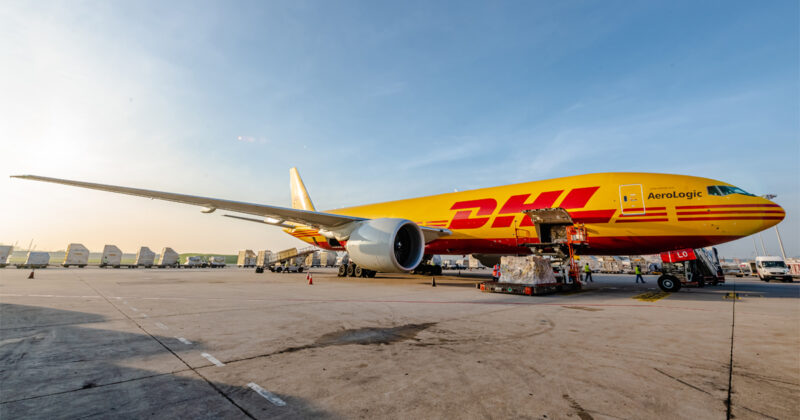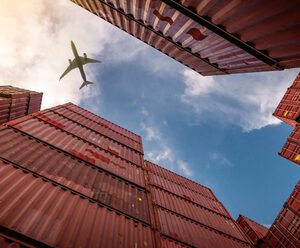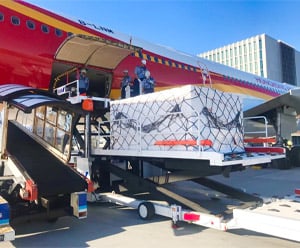ECブームが牽引するアジアの航空貨物需要

新型コロナウイルスの感染拡大が進むなか、世界中の旅客機が駐機場で待機状態になっている一方で、航空貨物機はある種の復活を果たしました。
渡航禁止令が出されたために旅客機は地上にとどまり、そのため航空貨物輸送に利用できるベリースペースが不足しました。
国境を越えた旅行が再開される兆候はほとんどないなかで、貨物スペースの需要は堅調で、常に利用可能なキャパシティを超えるほどの勢いがある状況は、今後も続くと予想されています。
国際航空運送協会(IATA)のデータによると、パンデミックの発生以降、今年1月に初めて、航空貨物需要が コロナ禍以前のレベル に戻ったことが示されています。 2月の取引量 はさらに増加し、米中貿易戦争前の2018年の水準に戻りました。
パンデミックの初期段階では、医薬品や個人用防護具(PPE)などの医療用物資、およびEC関連の出荷が、航空貨物のキャパシティの大部分を占めていました。その後、医療用個人用防護具の需要は落ち着きましたが、企業のサプライチェーンが動き出し、ECによる出荷需要は堅調に推移しただけでなく、顕著な上昇も見られました。
DHLエクスプレスアジア太平洋地区CEOであるケン リーは、「ECは、新型コロナウイルスのパンデミック以降、アジアの小売事業者や消費者の間で人気が高まり、親しまれるようになりました。より多くの中小企業がオンラインに参入し、新しいインターネット利用者を含むより多くの消費者に対応しています。」と述べています。
コロナ禍を受けた消費者のライフスタイルの変化
オンラインショッピングを選ぶ理由が利便性であろうと、実店舗で買い物ができないためであろうと、多くの消費者は、パンデミックによるロックダウンや規制に適応して、習慣やライフスタイルを変えています。
これにより、ECの成長が加速し、オンラインの生活スタイルへの移行がますます進み、この現象は、業界関係者によると「もうあと戻りできない」とまで表現されています。
アジアは、ECの成長を牽引する中心的な役割を果たしています。 特に、東南アジアのEC市場は、2025年までに23%成長し、 1,720億米ドル(1,420億ユーロ)規模に 達すると予想されています。
サプライヤーや企業は、この動向をいち早く認識し、この成長の勢いに乗ろうと積極的に動いています。2020年のGoogle社、Temasek社、Bain&Company社による調査では、オンライン販売に関する検索エンジンでの検索数は昨年より伸びており、マレーシアとベトナムではそれぞれ5倍と6倍もの急激な増加が見られました。
活況を呈するECセクターの恩恵を享受しているのは、Shopeeなどのような地域で人気のあるECマーケットプレイスです。Shopeeは、昨年の第1四半期に商品総額が74.3%増加し、62億米ドル(51億2000万ユーロ)に達しました。
ロックダウンや規制緩和など、各国はさまざまな段階にあり、パンデミックがきっかけとなって起こったこのECブームは、まだその地域に潜在需要がある限り、当分続くだろう」と、リーは付け加えました。
2020年単年で、東南アジアの新規インターネットユーザー数は4,000万人増加し、現在、この地域の総人口の70%がデジタルサービスを使用しています。
コロナ禍でEC取引が急成長:DHLエクスプレス
コロナ禍でEC取引が急成長:DHLエクスプレス
アジア太平洋地域(中国を除く)でDHLエクスプレスは、2020年ピークシーズンとなる11月から12月にかけての貨物取扱量が、前年比17.3%増加しました。主な要因としては、出荷ニーズが旺盛であったことと、顧客あたり21%の増加を見せた支出によるものです。.
その2ヵ月間で、B2Cの貨物量が65%増加し、その成長には、消費者向けテクノロジー製品とファッションアパレル製品が最も貢献しました。
出典: 究極のB2B ECガイド
航空貨物キャパシティの逼迫を緩和する
DHLエクスプレスにとって、信頼性が高く、迅速でタイムリーな配達への期待が高まっている顧客のニーズを満たすことが重要です。
DHLエクスプレスアジア太平洋地区ネットワークオペレーションおよびアビエーション担当エグゼクティブバイスプレジデントであるショーン ウォールは、「急増するECユーザーは、中長期的にはサプライチェーンや航空貨物輸送に対して、より高い効率性と配送スピードを求め続けるでしょう。」と述べています。
この地域の国際航空輸送能力は依然として限られていますが、DHLエクスプレスは最近、増大する貨物需要に対応すべく新規フライトを導入し、アジア太平洋地域のネットワークにおける航空貨物輸送能力を強化しました。
香港にあるDHLエクスプレスのセントラルアジアハブからは、成長著しいベトナムのホーチミンとマレーシアのペナンにそれぞれ直行便が就航します。
週6便のホーチミン-香港線では、エアバスA330型機で最大62トンの航空貨物を輸送し、週5便以上のペナン線では、エアバスA300型機(総重量54トン)で輸送します。これにより、オンライン事業者は、顧客サービスの向上と効率化を図ることができ、また、地域内での事業拡大を図ることができます。
また、DHLエクスプレスは、アジア太平洋地域のネットワークにおいて、パートナー航空会社であるカリッタエアおよびエアロ・ロジックと協力し、同地域における航空貨物の輸送能力を週2,350トン追加します。 この強化策では、ボーイング777型貨物機を活用し、特にオセアニア地域での国際エクスプレス輸送の需要増加に対応します。
カリッタエアのサービスは、シンシナティとロサンゼルスのゲートウェイから、シドニーを経由してシンガポールのDHLエクスプレス南アジアハブへ週5回運航します。シンガポールからは、香港とアラスカのアンカレッジに立ち寄り、シンシナティに戻る予定です。 また、カリッタエアは、シンガポールとシドニーを週6回結ぶ新路線も運航します
もう1機は、DHLエクスプレスとルフトハンザカーゴの合弁貨物航空会社、エアロ・ロジック社が運航するもので、ライプチヒから香港、シンガポールへ週6便を運航した後、バーレーンに立ち寄ってライプチヒに戻る予定です。
「今回の新路線開設により、オーストラリアやニュージーランドの企業や消費者の皆様は、グローバルな展開を目指す米国や欧州との貨物輸送時間の短縮が期待できます。」
「新しい航空機への投資とおよび専用路線の増便は、アジア太平洋地域の成長に対する私共の確信と、成長著しいECセクターの促進へのコミットメントを示すものです。」とリーは述べています。












 日本語
日本語